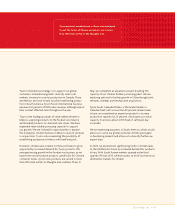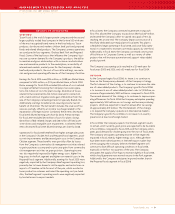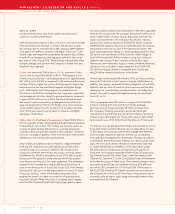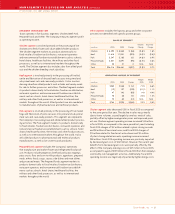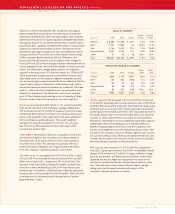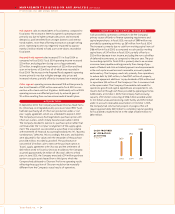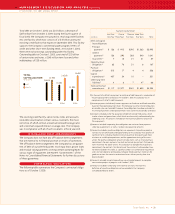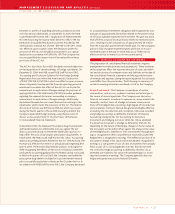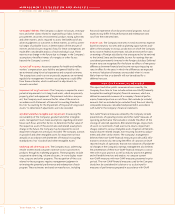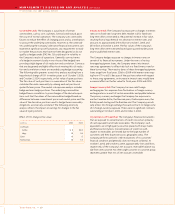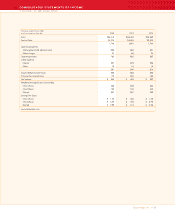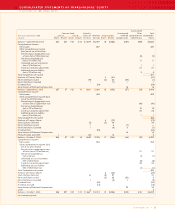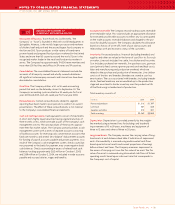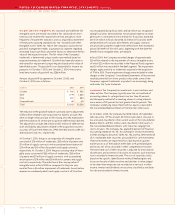Tyson Foods 2005 Annual Report Download - page 28
Download and view the complete annual report
Please find page 28 of the 2005 Tyson Foods annual report below. You can navigate through the pages in the report by either clicking on the pages listed below, or by using the keyword search tool below to find specific information within the annual report.
>> MANAGEMENT’S DISCUSSION AND ANALYSIS (CONTINUED)
TYSON FOODS, INC. 2005 ANNUAL REPORT
Tyson Foods, Inc. >> 26
RECENTLY ISSUED ACCOUNTING
STANDARDS AND REGULATIONS
In March 2005, the Financial Accounting Standards Board (FASB)
issued Interpretation No. 47, “Accounting for Conditional Asset
Retirement Obligations,” an interpretation of FASB Statement
No. 143 (the Interpretation). Statement of Financial Accounting
Standards No. 143, “Accounting for Asset Retirement Obligations”
(SFAS No. 143), was issued in June 2001 and requires an entity to
recognize the fair value of a liability for an asset retirement obliga-
tion in the period in which it is incurred if a reasonable estimate of
fair value can be made. SFAS No. 143 applies to legal obligations
associated with the retirement of a tangible long-lived asset that
resulted from the acquisition, construction, development and (or)
the normal operation of a long-lived asset. The associated asset
costs are capitalized as part of the carrying amount of the long-
lived asset. The Interpretation clarifies that the term “conditional
asset retirement obligation” as used in SFAS No. 143, refers to a legal
obligation to perform an asset retirement activity in which the
timing and (or) method of settlement are conditional on a future
event that may or may not be within the control of the entity. The
Interpretation requires an entity to recognize a liability for the fair
value of a conditional asset retirement obligation if the fair value
of the liability can be reasonably estimated. Uncertainty about the
timing and (or) method of settlement of a conditional asset retire-
ment obligation should be factored into the measurement of the
liability when sufficient information exists. SFAS No. 143 acknowl-
edges that in some cases, sufficient information may not be
available to reasonably estimate the fair value of an asset retire-
ment obligation. The Interpretation is effective for fiscal years
ending after December 15, 2005. The Company is currently in the
process of evaluating any potential effects of the Interpretation
but does not believe its adoption will have a material impact on
its consolidated financial statements.
In December 2004, the FASB issued Statement of Financial
Accounting Standards No. 123R, “Share-Based Payment”
(SFAS No. 123R), which is a revision of FASB Statement No. 123,
“Accounting for Stock-Based Compensation” (SFAS No. 123).
SFAS No. 123R supersedes Accounting Principles Board (APB)
Opinion No. 25, “Accounting for Stock Issued to Employees,” and
amends FASB Statement No. 95, “Statement of Cash Flows.” The
revision requires companies to measure and recognize compensa-
tion expense for all share-based payments to employees, including
grants of employee stock options, in the financial statements based
on the fair value at the date of the grant. SFAS No. 123R permits
companies to adopt its requirements using either the modified
prospective method or the modified retrospective method.
Under the modified prospective method, compensation cost is
recognized beginning with the effective date for all share-based
payments granted after the effective date and for all awards granted
to employees prior to the effective date of SFAS No. 123R that
remain unvested on the effective date. The modified retrospective
method includes the requirements of the modified prospective
method, but also permits entities to restate either all prior periods
presented or prior interim periods of the year of adoption for
the impact of adopting this standard. The Company will apply
the modified prospective method upon adoption. In April 2005,
the Securities and Exchange Commission announced it would
provide for phased-in implementation of SFAS No. 123R. As a result,
SFAS No. 123R is effective for the first interim or annual reporting
period of the registrant’s first fiscal year beginning on or after
June 15, 2005. The Company estimates that compensation expense
related to employee stock options for fiscal 2006 is expected to
be in the range of $10-$15 million. SFAS No. 123R also requires the
benefits of tax deductions in excess of recognized compensation
costs to be reported as financing cash flow, rather than as an
operating cash flow as required under current literature. This
requirement will reduce net operating cash flows and increase
net financing cash flows in periods after adoption. The Company
believes this reclass will not have a material impact on its
Consolidated Statements of Cash Flows.
In December 2004, the FASB issued Statement of Financial Account-
ing Standards No. 151, “Inventory Costs” (SFAS No. 151). SFAS No. 151
requires abnormal amounts of inventory costs related to idle facil-
ity, freight handling and wasted material expenses to be recognized
as current period charges. Additionally, SFAS No. 151 requires that
allocation of fixed production overheads to the costs of conver-
sion be based on the normal capacity of the production facilities.
The standard is effective for fiscal years beginning after June 15,
2005. The Company believes the adoption of SFAS No. 151 will not
have a material impact on its consolidated financial statements.
In October 2004, the President signed into law the American Jobs
Creation Act (the AJC Act). The AJC Act provides for the elimina-
tion of the ETI and allows for a federal income tax deduction for a
percentage of income earned from certain domestic production
activities. The Company’s domestic, or U.S., production activities
will qualify for the deduction. Based on the effective date of this
provision of the AJC Act, the Company will be eligible for this
deduction beginning in fiscal 2006. This provision will be phased in
from fiscal 2006 through fiscal 2011 and provides for a deduction of



